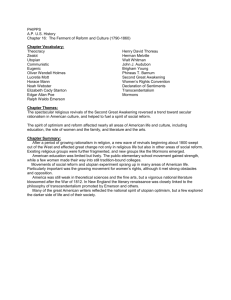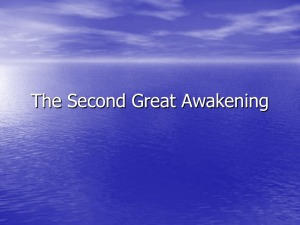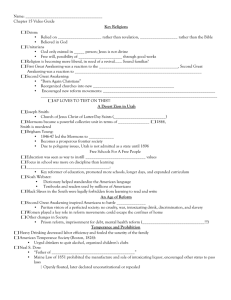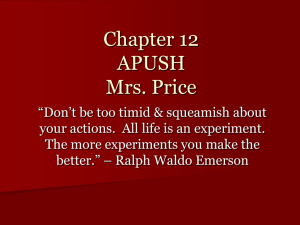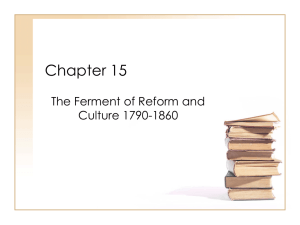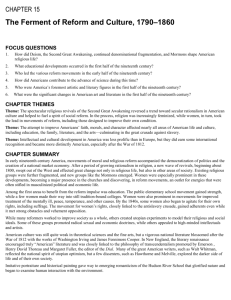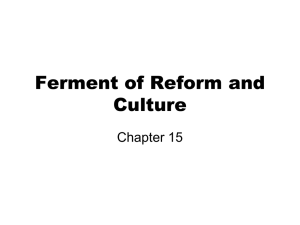Reform movements between 1800 and 1860
advertisement
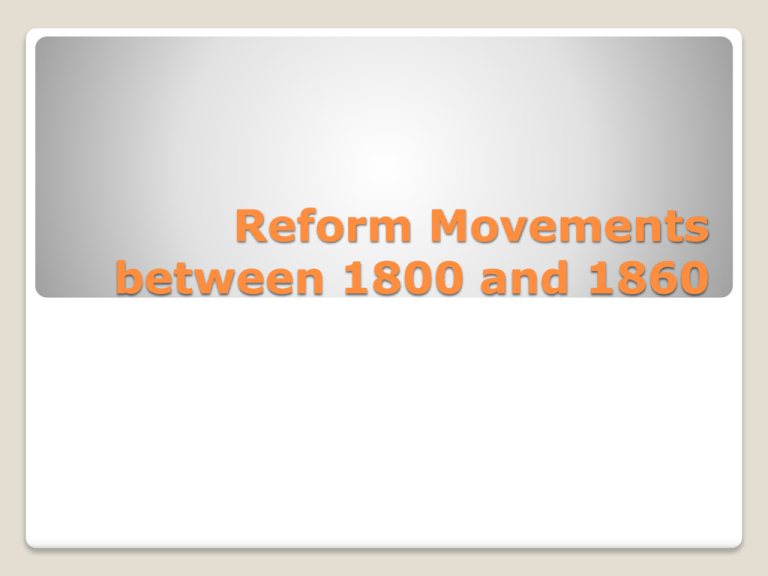
Reform Movements between 1800 and 1860 Second Great Awakening In the early 1800s a Religious fervor sweeps the nation. Revivalist ministers preached all over the nation, especially on the Frontier and a spirit for change and reform swept across the country. https://video.search.yahoo.com/video/play?p=brother+love%27s+traveling+salvation+show&vid=cd31248f95b1e4db534a7f231016c078&l=4%3A54&turl=http%3A%2F%2Fts1.mm.bing.net%2Fth %3Fid%3DVN.608024106630187444%26pid%3D15.1&rurl=http%3A%2F%2Fwww.youtube.com%2Fwatch%3Fv%3DVdjfR95thiE&tit=brother+love%26%2339%3Bs+traveling+salvation+showneil+diamond&c=12&sigr=11aj3js7c&sigt=11oa70t4o&sigi=11r6i7j93&back=https%3A%2F%2Fsearch.yahoo.com%2Fyhs%2Fsearch%3Fp%3Dbrother%2Bloves%2Btraveling%2Bsalvation%2Bs how%2Bvideo%26ei%3DUTF-8%26hsimp%3Dyhs-001%26hspart%3Dmozilla&sigb=13ojo09sg&ct=p&age=1411935302&fr2=p%3As%2Cv%3Av&hsimp=yhs-001&hspart=mozilla&tt=b Charles Grandison Finney Mormons, Transcendentalists and Utopian Communities While mainstream religions grew in large numbers, during this time many smaller religious sects also spring up, including groups like Mormons, the Transcendentalists as well as other Utopian Communities. Joseph Smith Brigham Young Ralph Waldo Emerson Henry David Thoreau 1) How did the 2nd Great Awakening spark religious and social change, as well as religious discrimination? 2) How did differing religious beliefs contribute to an increase in the sectional Brook Farm today divisiveness of the country? 2nd Great Awakening Charles Grandison Finney/evangelism Richard Allen/AME Church Joseph Smith and Brigham Young / Mormons utopian communities Brook Farm/New Harmony Transcendentalism Emerson and Thoreau Quakers Richard Allen Education, Mental Hospital System, and Prison Reform, and the Temperance Movement The reform and revival spirit of the second great awakening spurred a movement to reform other aspects of society as well. Listed above are some of the most famous reform movements. Dorothea Dix Horace Mann 1) How is change influenced by the actions of citizens? 2) In what ways did religious influence impact the effectiveness of social movements in the first part of the 19th century? Horace Mann Public school movement Dorothea Dix Temperance movement Neal Dow Rehabilitation Prison Reform Pennsylvania System Auburn Model Neal Dow Abolitionism Springing from the reforming fervor of the Second Great Awakening, abolitionism picked up steam. During this time, abolitionist newspapers like the Liberator were founded and Books such as Uncle Tom’s Cabin brought widespread attention to the issue. William Lloyd Garrison Harriet Beecher Stowe Nat Turner 1) How did both sides of the abolitionist movement use religion to support their viewpoint? 2) What were other arguments for and against abolitionism? William Lloyd Garrison/ The Liberator emancipation Nat Turner Frederick Douglass Sojourner Truth David Walker Harriet Beecher Stowe Uncle Tom’s Cabin “necessary evil” Frederick Douglass Gag Rule The American Anti-Slavery Society Sojourner Truth David Walker The (early) Women’s Movement Women who were a central part of the social reform and abolitionist movements decided that they too deserved equal rites. This led to the beginning of the women’s movement. Sarah and Angelina Grimke Elizabeth Cady Stanton Lucretia Mott 1) How was the women’s movement connected to abolitionism and other reform movements of the time? 2) How did different groups of leaders disagree with regard to what should be the aims of the Amelia Bloomer women’s rights movement? Susan B. Anthony Women’s Rights The Grimke Sisters (Quakers) Elizabeth Cady Stanton Lucretia Mott Margaret Fuller Seneca Falls Convention Susan B. Anthony Amelia Bloomer Married Women’s Property Act The Declaration of Sentiments Margaret Fuller

